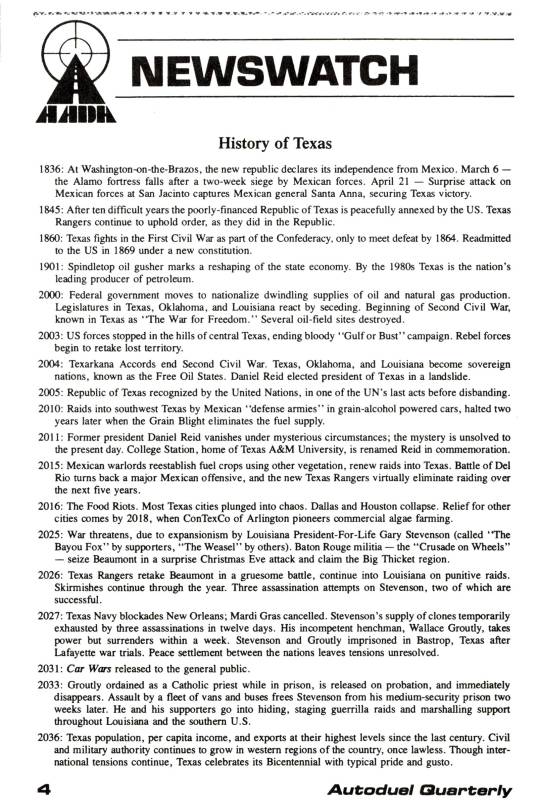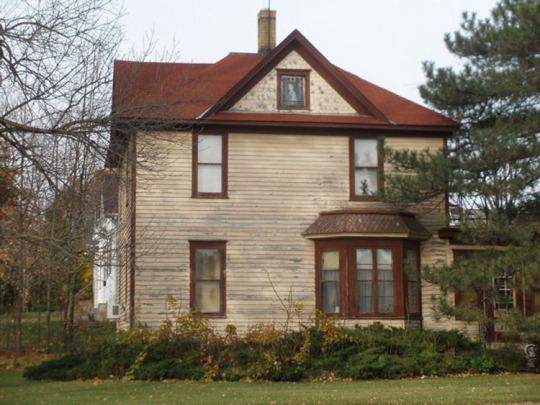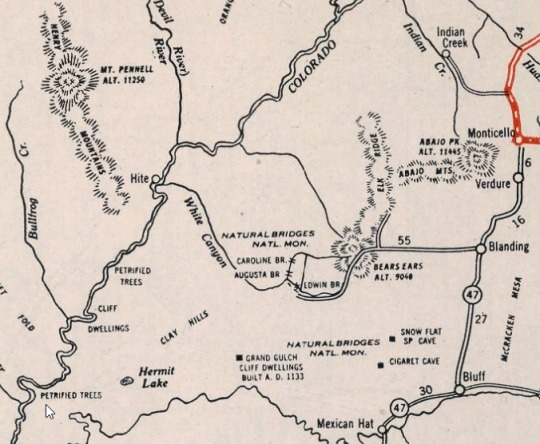#Bicentennial Highway
Explore tagged Tumblr posts
Text
American Auto Trail-Bicentennial Highway Part 2 (Fry Canyon to Glen Canyon UT)
American Auto Trail-Bicentennial Highway Part 2 (Fry Canyon to Glen Canyon UT) https://youtu.be/LlntSN1zYbs This is part 2 of our exploration of the Bicentennial Highway in southern Utah.

View On WordPress
#4K#american history#Auto trail#Bicentennial Highway#Colorado River#Fry Canyon#Glen Canyon#Henry Mountains#Natural Bridges#road travel#slow travel#utah#White Canyon
0 notes
Text

State Route 95 or Bicentennial Highway is a state highway located in the southeast of the U.S. state of Utah. The highway is an access road for tourism in the Lake Powell and Cedar Mesa areas, notably bisecting Bears Ears National Monument and providing the only access to Natural Bridges National Monument.
258 notes
·
View notes
Text










Fort Vermilion, AB (No. 4)
Fort Vermilion is located approximately 85 km (53 mi) southeast of High Level and 661 km (411 mi) northwest of Edmonton on the Highway 88 (Bicentennial Highway). The hamlet of La Crete is located approximately 47 km (29 mi) southwest of Fort Vermilion on Highway 697.
The hamlet is one of the northernmost communities in the Peace River Country. Peace Country, in the aspen parkland biome, is Canada's northernmost land suitable for agriculture. The landscape is dominated by aspen, poplars and spruce, occasionally interspersed with areas of grasslands. Wildlife is abundant in the area, and includes bears, moose, deer, beavers, foxes, coyotes and Canada geese and Sandhill cranes
The hamlet is situated on the southern banks of the Peace River, with an elevation ranging from 255 to 282 m (837 to 925 ft) and the Indian reserve of Fort Vermilion 173B is about a kilometre east. The North Vermilion Settlement lies on the opposite (northern) shore of the river, while Fort Vermilion (Wop May Memorial) Aerodrome is located directly beside the hamlet on the north east side.
Source: Wikipedia
#Fort Vermilion#Peace River#wildfire smoke#river bank#travel#original photography#vacation#Alberta#Canada#summer 2024#nature#flora#tourist attraction#landmark#fauna#small town#northern Alberta#cityscape#Mackenzie County#Peace River Country#countryside#canola field#farm land
2 notes
·
View notes
Text

The history of Texas from the March 6, 1836, fall of the Alamo, through the societal collapse of the early 2000s, the rise of autoduelling as a sport and a highway hazard, to the Bicentennial year of 2036 ("Newswatch" column by Allen Varney, Car Wars magazine Autoduel Quarterly V4 N3, "Fall 2036, Special Texas Bicentennial Issue," Steve Jackson Games, September 1986)
#Car Wars#Autoduel Quarterly#Steve Jackson Games#sci fi#postapocalyptic#board game#Texas#Allen Varney#American Autoduel Association#AADA
52 notes
·
View notes
Text















Arrivals & Departures . 01 December 1940 – 10 December 2005 . Richard Franklin Lennox Thomas Pryor Sr.
Richard Franklin Lennox Thomas Pryor Sr. was an American stand-up comedian and actor. He reached a broad audience with his trenchant observations and storytelling style, and is widely regarded as one of the greatest and most important stand-up comedians of all time. Pryor won a Primetime Emmy Award and five Grammy Awards. He received the first Kennedy Center Mark Twain Prize for American Humor in 1998. He won the Writers Guild of America Award in 1974. He was listed at number one on Comedy Central's list of all-time greatest stand-up comedians. In 2017, Rolling Stone ranked him first on its list of the 50 best stand-up comics of all time.
Pryor's body of work includes numerous concert films and recordings. He won the Grammy Award for Best Comedy Album for That Nigger's Crazy (1974), ...Is It Something I Said? (1975), Bicentennial Nigger (1976), Richard Pryor: Live on the Sunset Strip (1982), and Richard Pryor: Here and Now (1983). He is also known for Richard Pryor: Live & Smokin' (1971), Wanted: Live in Concert (1978), and Richard Pryor: Live in Concert (1979). Pryor served as a co-writer for the Mel Brooks satirical western comedy film Blazing Saddles (1974).
As an actor, he starred mainly in comedies. He gained acclaim for his collaborations with Gene Wilder, including the films Silver Streak (1976), Stir Crazy (1980), See No Evil, Hear No Evil (1989), and Another You (1991). He also acted in films such as Uptown Saturday Night (1974), Blue Collar (1978), The Wiz (1978), California Suite (1978), Superman III (1983), Harlem Nights (1989), and Lost Highway (1997). He appeared as himself on Sesame Street and Saturday Night Live before hosting The Richard Pryor Show (1977), and Pryor's Place (1984).
0 notes
Text
1976 OFFICIAL Indiana State Highway Road Map Bicentennial Tourist Guide Brochure
PAINCORP SPECIAL: Seller: paincorp (100.0% positive feedback) Location: US Condition: Unspecified Price: 4.00 USD Shipping cost: Free Buy It Now https://www.ebay.com/itm/185938898072?hash=item2b4ad26c98%3Ag%3ALYcAAOSw2A9eqMIi&mkevt=1&mkcid=1&mkrid=711-53200-19255-0&campid=5338779484&customid=&toolid=10049&utm_source=dlvr.it&utm_medium=tumblr
0 notes
Photo




Bullskin Trace Monument
6585 OH-133
Goshen OH 45122
The earliest "roads" in Clermont County, Ohio were traces made by the hoofs of animals and footsteps of Native Americans. The most significant trace in the county was the Bullskin Trace, also known as the Xenia Trace. The Bullskin entered the county from Kentucky and passed through the center of the Shawnee Nation to Chalahgawtha, the principal village of the Shawnee in the 1770s and 1780s. The Bullskin Trace entered Clermont County at the point where the Bullskin Creek enters the Ohio River (a good fording point across the Ohio River in early times) near Rural (the Hamlet was destroyed in the 1913 flood). It follows an alignment of present day SR 133, passing through Felicity, Bethel, Williamsburg and Edenton. It departs the county northeast of the village.
In prehistoric times it was used as a path to the Great Salt Licks located in Kentucky. The trail was shared by large game animals and the various Native American cultures which inhabited the area. The landing site at the mouth of Bullskin Creek served as a debarkation point for many settlers. The Trace served as a route to the interior of the county and as a result the development of the villages along it. As the settlers infiltrated the area the Trace was improved and became a road. The Trace was used was by Daniel Boone on his escape from the Shawnee at Chalahgawtha in 1778. During the Indian Wars (1793) a vanguard of Gen. Anthony Wayne's Army moved up the Trace and had a skirmish with Shawnee Indians near Stonelick Creek. Ammunition and supplies were transported up the Trace to Admiral Perry's fleet on Lake Erie during the War of 1812. The Trace served as part of the Underground Railroad that was traveled by slaves headed to Canada.
In 1807 the Ohio State legislature enacted a law designating the trace as the Xenia State Road, one of the first roads in Ohio, and appropriated funds to improve it. The Willing Workers of Edenton and the Blanchester Daughters of American Revolution erected a stone monument just east of Edenton in 1927 to celebrate the sesquicentennial of Boone's escape. The monument still stands. In 2000 the Clermont County Bicentennial Committee erected a historical marker near the monument to commemorate the historical significance of the Bullskin Trail. The marker is in Edenton, Ohio, in Clermont County on Ohio Route 133, 0.2 miles south of Edenton-Pleasant Plain Road (Ohio Route 727), on the left when traveling north. It is off the highway on a private drive.
0 notes
Text
What Makes Cheatham County a Hotspot for Real Estate Investment?

Are you considering investing in real estate? Cheatham County could be an excellent choice with its access to numerous amenities, superb school system, peaceful natural surroundings and desirable housing market. From exclusive neighborhoods perched atop the rolling hills to small-town living nestled among lush timberlands, this Tennessee locale has something for everyone looking for a place to call home or a good investment opportunity.
In this blog post, we'll discuss what makes Cheatham County such a hot spot for real estate investors so that you can make an informed decision. So let's dive right into it.
Economic Growth and Development

Economic growth and development in Cheatham County is on the rise with the emergence of new job opportunities and businesses. The county's strategic location and access to major metropolitan areas create an attractive environment for both small and large industries. With an increase in businesses, the demand for skilled labor like real estate agents and more has grown, leading to a surge in job openings.
This not only offers employment opportunities for residents but also attracts individuals from neighboring counties. As the economy continues to expand, more people are moving to Cheatham County, causing a rise in population growth and demand for property. This trend has significant implications for the county's economic future as it presents new opportunities for investment and innovation.
Location and Accessibility

Cheatham County is located in Middle Tennessee and is conveniently situated near Nashville and other major cities, making it an accessible area for both residents and visitors. With its proximity to Nashville, the state capital, residents of Cheatham County have easy access to a variety of cultural and recreational activities, including music venues, museums, and sports events.
Additionally, the transportation infrastructure in the county makes travel easy and convenient, with major highways and Interstates connecting the area to neighboring cities and states.
Natural Beauty and Attractions
Cheatham County offers a wide range of natural beauty and attractions that make it a great location for real estate investment. These attractions include:
1. Outdoor Recreation Opportunities: Cheatham County has a variety of opportunities for enjoying the great outdoors. The Ashland City Bicentennial Trail is a scenic 1.3-mile paved trail ideal for biking, walking, or jogging with beautiful views of the Cumberland River. The Harpeth River also offers opportunities for kayaking, fishing, and boating as well as hiking, camping, and exploring the river's stunning beauty
2. Historical and Cultural Attractions: Cheatham County is rich in history and has several cultural attractions to offer. The county is home to the Bell Witch Cave, a historic site known for its spooky tales and folk legends. It also has Civil War sites such as Ashland City Railroad Trestle, Sycamore Mills, and Port Royal State Park. There are also other museums and historic sites that offer interesting exhibits and events throughout the year.
3. Parks and Festivals: Cheatham County is home to several parks and festivals that offer plenty of family-friendly activities. Harpeth River State Park, Cheatham Dam & Locks Park, Harpe's Creek Wildlife Management Area, and Carlisle-Gordon Access Area all offer picnic areas, camping grounds, and many activities for the outdoor adventurer. In September, the county hosts an annual river festival that features live music, food trucks, and other fun activities for everyone.
Low Cost of Living and Affordable Property Prices
Cheatham County is an ideal location for real estate investment due to its affordable cost of living and property prices. Below are some factors that make Cheatham County a great destination for those looking to live comfortably without breaking the bank:
Comparison of Home Prices in Cheatham County to Surrounding Areas
Home prices in Cheatham County are significantly lower than in the larger cities in the area such as Nashville and Brentwood. Median home prices in Cheatham County is around $190,000 while in Nashville it is around $315,000. This means that buyers can save thousands of dollars by opting for a property in Cheatham County while still enjoying access to the charming suburban lifestyle that defines the area. The lower home prices make it a great place for families, first-time homebuyers, and retirees.
Cost of Living Index in Comparison to Other Cities and States
The cost of living in Cheatham County is lower than the national average. This is excellent news for those looking to live in the area without incurring high costs of basic needs. Cheatham County’s cost of living index is 85.5 which is lower compared to the national average of 100. It is also lower than other big cities like New York, San Francisco, and Los Angeles which have a cost of living index of over 150. As such, residents of Cheatham County can enjoy a comfortable lifestyle without having to break the bank.
No state income tax in Tennessee
One significant benefit of investing in Cheatham County is that Tennessee has no state income tax. This means that residents can keep more money in their pockets and have more to spend on things that matter to them. This can be a significant financial advantage for homebuyers, especially those that operate small businesses.
Potential Future Developments and Investments
Investing in potential future developments is a wise strategy for those looking to grow and diversify their portfolios. By researching planned projects and developments in a particular area, investors can gain insight into where the greatest opportunities for growth and return on investment may lie. As cities and suburbs continue to grow and expand, the potential for increased property values also rises.
However, it is important to approach a real estate agent for any investment with caution and thorough analysis, to ensure that the potential for growth aligns with your financial goals and risk tolerance. As with any investment, there is always some level of uncertainty, but by staying informed and proactive, investors can position themselves for success in a changing landscape.
Conclusion
Cheatham County is truly a real estate investor’s dream area. With its low cost of living, consistent population growth, and the potential to buy undervalued properties, you can find success in any investment opportunity you choose. Real estate investors should consider buying in this highly appealing region now while they still can—opportunities won’t last forever.
By understanding the local market conditions and staying informed on the latest trends, you will be able to maximize your return on investment. With patience and dedication, Cheatham County may just become your next successful venture.
Visit these pages to learn more about real estate investment through Realtor in Cheatham County:
Socials:
Sherry Bowman's Facebook Page
Sherry Bowman's Instagram Page
Sherry Bowman's Twitter Page
Sherry Bowman's YouTube Page
Sherry Bowman's Reddit Page
Sherry Bowman LinkedIn Profile
Citations:
Sherry Bowman Mapquest
Sherry Bowman Bing
Sherry Bowman Yahoo
Sherry Bowman Zillow Page
1 note
·
View note
Text



What’s that in the Window? The Eerie Legend of the Janesville Doll
Janesville, Minnesota is a fine example of small town America. With a population of just over 2,000 people, it’s the kind of community you drive through at an easy pace—or pass by at a distance. Today, Highway 14 sidesteps Main Street Janesville entirely.
Still, until a few years ago, curiosity seekers followed the old Highway 14 route to 1st Street in search of a peculiar local mystery. Their destination? An unassuming house with an eerie figurine framed in the attic window, its blank stare peering out of the glass.
It was known as the Janesville Doll.
What was the secret of the Janesville Doll? Who put him there, and why? Dozens of explanations cropped up over the years—some more fanciful than others. Eventually, the small-town mystery transformed into a full-blown urban legend.
The story of the doll centers on the house’s owner and the death of the owner’s young daughter. Her demise changed depending on which account you heard; in some versions she succumbed to illness or a tragic accident, while in others her end was far grislier.
In one dark tale, the girl was abused and neglected by her family. Neighbors feared her; she soon became a prisoner of her attic room. There she would sit and stare out the attic window as the world passed by without her.
Overwhelmed with sorrow, the girl hanged herself. Her parents, realizing what they had done, placed the doll in the attic window as a memorial.
Soon there after, the Janesville Doll allegedly sprung to life.
Visitors claimed to see that the doll sometimes changed position, or that its placid expression transformed into anger, glaring at onlookers from behind the glass.
Such claims help explain a demonic twist to the Janesville Doll legend. This version also centers on the demise of a little girl in the house, but maintains that it was the result of demonic possession. The child died during an exorcism, and it was the demon itself that entered the doll—threatening to possess anyone who dared gaze into the doll’s eyes for too long.
As for the facts of the Janesville Doll case, they too remain shrouded in mystery. The home that housed the doll once belonged to man named Ward Wendt. Wendt was born in the house, and lived there until old age. He was reportedly a collector of antiques and train memorabilia. He placed the doll in the window sometime in 1976, never telling a soul why he did it.
According to Wendt, the house had belonged to his family since Janesville was founded, and nothing “exciting” had ever happened on the property. There appears to be no record of suspicious deaths or mysterious events associated with the house to give credence to the many tales surrounding the doll. In 2012, at the age of 84, Ward Wendt passed away, taking the secret of the Janesville Doll to his grave.
Or maybe not. One final tale about the doll might hold the key to the mystery. The same year the doll first appeared in the window of Wendt’s home, Janesville buried a time capsule in a nearby park in honor of the United States Bicentennial. In that time capsule, Wendt is said to have placed a note in which he reveals his reasons for putting the doll in the window.
The only catch? The time capsule is not scheduled to be unearthed until 2176.
After Wendt’s death, the Janesville Doll was moved from the attic window to a special showcase in the Janesville Library. A Facebook account and MySpace page have since cropped up in honor of the legendary figurine. Whether it continues to inspire strange stories and paranormal reports among the library stacks, only time will tell.
#Janesville Doll#ghost and hauntings#paranormal#ghost and spirits#haunted locations#haunted salem#myhauntedsalem#haunted doll
11 notes
·
View notes
Text
American Auto Trail-Bicentennial Highway (Blanding to Fry Canyon UT)
American Auto Trail-Bicentennial Highway (Blanding to Fry Canyon UT) https://youtu.be/bKYNnHJ4ZyE Part 1 of this American Auto Trail explores Utah Highway 95, also known as the Bicentennial Highway.

View On WordPress
#4K#american history#Auto trail#Bicentennial Highway#Blanding#Cheesebox#Cobb Ridge#Fry Canyon#Natural Bridges#road travel#slow travel#utah#Zeke Johnson
0 notes
Photo

Harley E. Warrick (October 5, 1924 – November 24, 2000), was an American barn painter, best known for his work painting Mail Pouch tobacco advertising on barns across 13 states in the American Midwest and Appalachian states. Over his 55-year career, Warrick painted or retouched over 20,000 Mail Pouch signs. When he retired, he was the last of the Mail Pouch sign painters in America. The Mail Pouch signs have become iconic and some of Harley Warrick's work has been exhibited by the Smithsonian Institution. Though he was not the first or the only Mail Pouch barn painter, he was the most prolific and famous.
Warrick was born and raised in Londonderry, Ohio, where his family had a dairy farm. When he returned from service in World War II in 1946, he began painting his family's dairy barn with a team of Mail Pouch sign painters; they suggested he join them. Upon reflection, Warrick decided that it would be better than milking his family's Jersey cows each day so he began painting with the team. Having just returned from the Army, Warrick had no other clothes, so he painted barns for the first week in his uniform. It turned out to be the only job he ever had.
Warrick trained under a seasoned Mail Pouch barn painter, Maurice Zimmerman, who also painted ads for competitor Red Man tobacco, Simoniz car wax, and Minneapolis Milling Company. Warrick and a partner traveled from town to town, sometimes sleeping in the back of a pickup truck or cheap motel. They were often on the road for months at a time. With the partner painting the black background and Warrick painting the letters, they were able to paint two barns a day, taking about six hours per barn. Warrick painted signs in Ohio, Pennsylvania, West Virginia, Maryland, Kentucky, Indiana, New York, Illinois, and Michigan.
Warrick used no template or tools, painting the sides of barns entirely by eye, and sometimes deliberately misspelled words to see how many phone calls the tobacco company would get about it. He had said that once in a while, he put three 'C's in 'TOBACCO' just to see if anyone noticed.
The Highway Beautification Act of 1965, which prohibited advertising billboards within 660 feet (200 m) of an interstate highway, effectively ended the era of painting the sides of barns for advertising. Though nearly all other sign painters went out of business, Warrick continued to work for the Swisher International Group, owner of Mail Pouch Tobacco, painting barns along lesser roads and highways until his retirement in 1991. When the Mail Pouch signs were designated as National Historic Landmarks, they were exempted from regulations against tobacco advertising and Warrick continued to paint. Mail Pouch did not suspend the barn painting advertising campaign until Warrick's retirement. Warrick is cited as an influence on Scott Hagan, who is noted for his barn paintings for the Ohio Bicentennial.
When he retired, Warrick continued to paint Mail Pouch signs on the sides of barn-shaped bird feeders and mailboxes that he would make and sell in his workshop in Belmont, Ohio. He died in a Wheeling, West Virginia, hospital in November 2000 of an aneurysm.
192 notes
·
View notes
Text










Lesser Slave Lake, AB (No. 3)
Due to its location on a major fly-way for migrating birds, Lesser Slave Lake is popular with birders. The nearby Lesser Slave Lake Provincial Park has lakeside camping facilities located along sand beaches, with some rocky beaches as well. Fishing is popular and legal. The entire north shore of the lake is protected, other reserves being Hilliard's Bay Provincial Park, Lesser Slave Lake Wildland and Grouard Trail Park Reserve.
Highway 2 and the Canadian National Railway follow the southern shore of the lake, and the Bicentennial Highway has its southernmost point at eastern end of the lake.
A number of Indian reserves are established at the shores of the lake:
Kapawe'no First Nations Lands 150, 230 and 231 of the Kapawe'no First Nation,
Sucker Creek 150a of the Sucker Creek Cree First Nation
Drift Pile River 150 of the Driftpile First Nation
Swan River 150e of the Swan River First Nation
Sawridge 150g and h Sawridge Band
Source: Wikipedia
#Devonshire beach#Lesser Slave Lake#Slave Lake#Upper Athabasca#travel#original photography#vacation#Alberta#Canada#summer 2024#nature#flora#lake shore#beach#tourist attraction#landmark#cityscape#a lot of inscets#fauna#small town#northern Alberta
4 notes
·
View notes
Photo









Moodboard for rural Ohio, specifically when you’re driving along the highway on your way home from a college that nobody from your hometown has ever heard of and you can’t remember the trip because everything looks the same. You’d swear you’ve seen that Grandpa’s Cheese Barn sign three time now—not to mention the bicentennial barn…
(photo sources: x x x x)
#moodboard#ohio#rural gothic#midwest gothic#barns#abandoned places#abandoned buildings#my photos#quarantine queue
256 notes
·
View notes
Text
Belleville: Bicentennial Park Walk
Belleville: Bicentennial Park Walk
Take a walk around ponds in the woods and let your kids explore nature-themed playgrounds at Bicentennial Park in Belleville, Ill. This hike is .8 miles long with 56 feet of elevation gain. The 43-acre park is not far from the Belleville Crossing Shopping Center and Illinois Highway 15. BICENTENNIAL WALK At the Trailhead My son joined me on the walk and we started it from the parking lot off…

View On WordPress
0 notes
Text
I was born in the year of the bicentennial. Solidly Gen X, I grew up in an era of hope. Gone were the days of cowering under desks to escape Russian bombs. Gone were all the archaic tropes of my parents’ generation, their quaint Cold War fears.
My first album was Thriller. The greatest threat to me as a child was the zombies who danced with Michael in the street. Delicious, MTV imagery, more choreography than chaos.
I learned Russian, the words perestroika and glasnost. Mr. Gorbachev did tear down many metaphorical walls and when the Berlin Wall itself was torn down by jubilant masses of ecstatic Germans, I took it as par for the course. And Yeltsin after him was the dancing bear, a charming Russian, who would fling open the doors of freedom where once an Iron Curtain had blocked our view.
The only demons who haunted my adolescence were the twin spectors of AIDS and drugs, both of which I had the power to keep out of my own life. If I practiced safe sex (or abstinence, though many of our Baby Boomer parents remained too mindful of the summers of love in their own pasts to proselytize that hard), I could protect myself. If I kept my experimentation under control or just said NO (though Nancy Reagan was a bore and anti-drug commercials are only good for quoting when one is high), I could protect myself. Imagine the agency we eighties and nineties teens possessed! It was within our own power to protect ourselves from the greatest threats to our welfare. We were in charge!
I came of age in an era without constant war, an era of widespread economic prosperity. There were problems, but they were lovely and salacious: blue dress scandals and white Broncos on the highway. Something called the World Wide Web was making millionaires out of everyone and I moved to California before anything crashed but the waves. Danced on a bar as Y2K failed to end the world.
As such, I cannot imagine what kids go through now. All their fears are real and impossible to protect against. They have to face a renewed Russian threat, one where the antagonist is literally everywhere, pretending to be your friend in cyberspace.Privacy is a non-starter. We are afraid of nuclear bombs again. And they could come from a variety of sources. There are terrorists on the news, who might blow you up or mow you down with a truck. The cops are shooting kids in the street and young men in their own backyards.
And people are bringing guns to school. And murdering children in their desks and hallways.
And it is our fault.
In the midst of our blissful Gen X ascension into adulthood we ignored the implications of Columbine. We let ourselves believe it was a freak moment. We did nothing.
We made no speeches. We organized no protests. We started no movements. We let Eric Harris and Dylan Klebold start us on a national path to nightmare and we did nothing.
I am so, so sorry. I am sorry families of Newtown, Connecticut and of Marjory Stoneman Douglas High School. I am so, so sorry that we did not demand action when we had the chance.
But I will stand with you now, you brave young adults of this fraught and terrible moment. If it is not too late. If you will have me. I will do what I can to help you while you bravely take agency in your own lives, while you fight back against the terror that your generation has been forced to face because mine was too distracted by AOL and grunge rock to do the hard and important work that needed to be done.
Thank you for showing us what bravery looks like.
Thank you for refusing to give in to terror and apathy.
Thank you.
We are Gen X and we are here. We are standing by. We are ready to help.
105 notes
·
View notes
Text
Brooklyn New York city limit highway marker road sign 1976 bicentennial 48x24
Brooklyn New York city limit highway marker road sign 1976 bicentennial 48×24
$319.00 End Date: Monday Feb-14-2022 18:44:43 ESTBuy It Now for only: $319.00Buy It Now

View On WordPress
0 notes